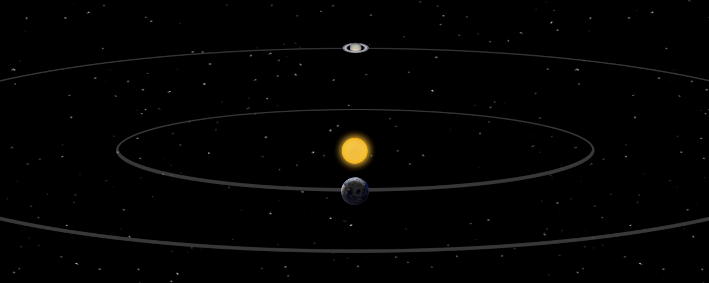Chapter 1: The Solar System
The planets Mercury, Venus, Earth, and Mars, are called terrestrial because they have a compact, rocky surface like Earth's terra firma. The terrestrial planets are the four innermost planets in the solar system. None of the terrestrial planets have rings, although Earth does have belts of trapped radiation, as discussed below. Among the terrestrials, only Earth has a substantial planetary magnetic field. Mars and the Earth's moon have localized regional magnetic fields at different places across their surfaces, but no global field.
Of the terrestrial planets, Venus, Earth, and Mars have significant atmospheres. The gases present in a planetary atmosphere are related to a planet's size, mass, temperature, how the planet was formed, and whether life is present.
The temperature of gases may cause their molecules or atoms to achieve velocities that escape the planet's gravitational field. This contributes to Mercury's lack of a permanent atmosphere, as does its proximity to the source of the relentless solar wind.
The presence of life on Earth causes oxygen to be abundant in the atmosphere, and in this Earth is unique in our solar system. Without life, most of the oxygen would soon become part of the compounds on the planet's surface. Thus, the discovery of oxygen's signature in the atmosphere of an extrasolar planet would be significant.
Mercury lacks an atmosphere to speak of. Even though most of its surface is very hot, there is strong evidence that water ice exists in locations near its north and south poles which are kept permanently shaded by crater walls. This evidence comes from Earth-based radar observations of the innermost planet. The discovery of permanently-shaded ice at the poles of Earth's moon strengthens arguments that the indications of ice on Mercury may be real.
Mercury was visited by Mariner 10 which flew by twice in 1974 and once in 1975, capturing images of one hemisphere. The Messenger spacecraft, which launched in 2004, made a series of flybys in 2008 and 2009 before settling into orbit on 18 March 2011.
Venus' atmosphere of carbon dioxide is dense, hot, and permanently cloudy, making the planet's surface invisible. Its best surface studies have come from landers and imaging radar from orbiting spacecraft.
Venus has been visited by more than 40 spacecraft. The Magellan mission used synthetic aperture radar imaging and altimetry to map its surface at high resolution from 1990 to 1994. The European Venus Express, launched in 2005, has been orbiting Venus since April 2006.
Earth, as of October 2016, is still the only place known to harbor life. And life has flourished here since the planet was young. Our home planet is also unique in having large oceans of surface water, an oxygen-rich atmosphere, and shifting crustal sections floating on a hot mantle below, described by the theory of plate tectonics. Earth's Moon orbits the planet once every 27.3 days at an average distance of about 384,400 km. The moon's orbital distance is steadily increasing at the very slow rate of 38 meters per millennium. Its distance at this point in its history makes the moon appear in the sky to be about the same size as the Sun, subtending about half a degree.
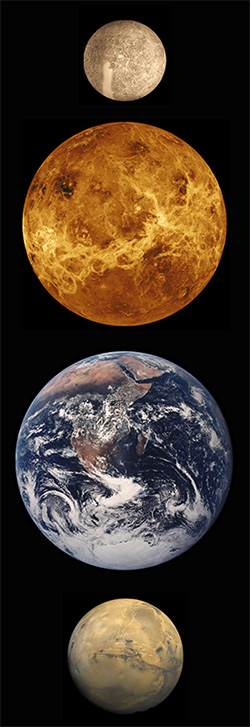
Earth's Radiation Environment: JPL's first spacecraft, Explorer 1, carried a single scientific instrument, which was devised and operated by James Van Allen and his team from the University of Iowa. Early in 1958 the experiment discovered bands of rapidly moving charged particles trapped by Earth's magnetic field in toroidal (doughnut-shaped) regions surrounding the equator.
The belts that carry Van Allen's name have two areas of maximum density. The inner region, consisting largely of protons with an energy greater than 30 million eV, is centered about 3,000 km above Earth's surface. The outer belt is centered about 15,000 to 20,000 km up, and contains electrons with energies in the hundreds of millions of eV. It also has a high flux of protons, although of lower energies than those in the inner belt.
Flight within these belts can be dangerous to electronics and to humans because of the destructive effects the particles have as they penetrate microelectronic circuits or living cells. Most Earth-orbiting spacecraft are operated high enough, or low enough, to avoid the belts. The inner belt, however, has an annoying portion called the South Atlantic Anomaly (SAA) which extends down into low-Earth-orbital altitudes. The SAA can be expected to cause problems with spacecraft that pass through it.
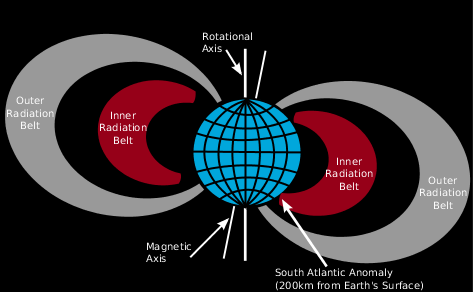
Mars' atmosphere, also carbon dioxide, is much thinner than Earth's, but it sustains wispy clouds of water vapor. Mars has polar caps of carbon dioxide ice and water ice. The planet's surface shows strong evidence for extensive water coverage in its distant past, as well as possible evidence for water flow in small springs during recent times.
Many spacecraft have been targeted for Mars, although many failed to reach their destination.
This table compares features of the terrestrial planets in terms of the values for Earth. Light minutes are often used to express distances within the region of the terrestrial planets, useful because they indicate the time required for radio communication with spacecraft at their distances. If you click on the planet's name at the top of the table, you'll see a complete set of technical data for the planet, with a comparison to Earth.
Mean distance from Sun (au) | 0.387 | 0.723 | 1 | 1.524 |
|---|---|---|---|---|
Light minutes from Sun | 3.2 | 6.0 | 8.3 | 12.7 |
Mass (x Earth) | 0.0553 | 0.815 | 1 | 0.107 |
Equatorial radius (x Earth) | 0.383 | 0.949 | 1 | 0.533 |
Rotation period (Earth days) | 175.942 | - 116.75 (retrograde) | 1 | 1.027 |
Orbit period (Earth years) | 0.241 | 0.615 | 1 | 1.881 |
Mean orbital velocity (km/s) | 47.87 | 35.02 | 29.78 | 24.13 |
Natural satellites | 0 | 0 | 1 | 2 |
Surface atmospheric pressure (bars) | Near 0 | 92 | 1 | .0069 to .009 |
Global Magnetic field | Faint | None | Yes | None |
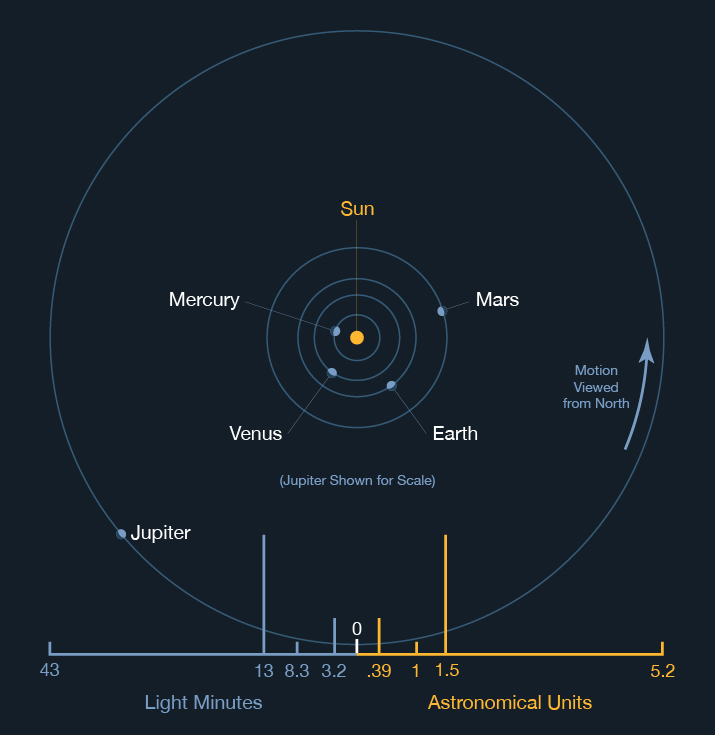
Though there are several named groups of asteroids, which are covered in the next section, the term "asteroid" has increasingly come to particularly refer to the small rocky and metallic bodies of the inner solar system out to the orbit of Jupiter. Millions of "main-belt" asteroids orbit the Sun mostly between Mars and Jupiter. Asteroids are also called minor planets.
Jupiter, Saturn, Uranus, and Neptune are known as the Jovian (Jupiter-like) planets, because they are all gigantic compared with Earth, and they have a gaseous nature like Jupiter's -- mostly hydrogen, with some helium and trace gases and ices. The Jovian planets are thus referred to as the "gas giants" because gas is what they are mostly made of, although some or all of them probably have small solid cores. All have significant planetary magnetic fields, rings, and lots of satellites.
Jupiter is more massive than all the other planets combined. It emits electromagnetic energy from charged atomic particles spiraling through its strong magnetic field. If this sizzling magnetosphere were visible to our eyes, Jupiter would appear larger then the full moon in Earth's sky. The trapped radiation belts near Jupiter present a hazard to spacecraft as do Earth's Van Allen belts, although the Jovian particle flux and distribution differ from Earth's. Bringing a spacecraft close to Jupiter presents a hazard mostly from ionized particles. Spacecraft intended to fly close to Jupiter must be designed with radiation-hardened components and shielding. Spacecraft using Jupiter for gravity assist may also be exposed to a harsh radiation dose. Instruments not intended to operate at Jupiter must be protected by being powered off or by having detectors covered.
Two spacecraft, Galileo and Juno, have orbited Jupiter, and several others have flown by: Pioneer 10, Pioneer 11, Voyager 1, Voyager 2, Ulysses, Cassini and New Horizons.
Saturn, the farthest planet easily visible to the unaided eye, is known for its extensive, complex system of rings, which are very impressive even in a small telescope. Using a small telescope one can also discern the planet's oblateness, or flattening at the poles. Continued study of Saturn's ring system can yield new understandings of orbital dynamics, applicable to any system of orbiting bodies, from newly forming solar systems to galaxies. Saturn's moons Titan, Enceladus, Iapetus, and others have proven to be extraordinarily interesting.
Pioneer 11 and the Voyagers flew by Saturn, and the Cassini spacecraft is currently studying the system from within Saturn orbit. The European Huygens Probe, carried by Cassini, executed a successful mission in Titan's atmosphere and on its surface on Jan. 14, 2005.
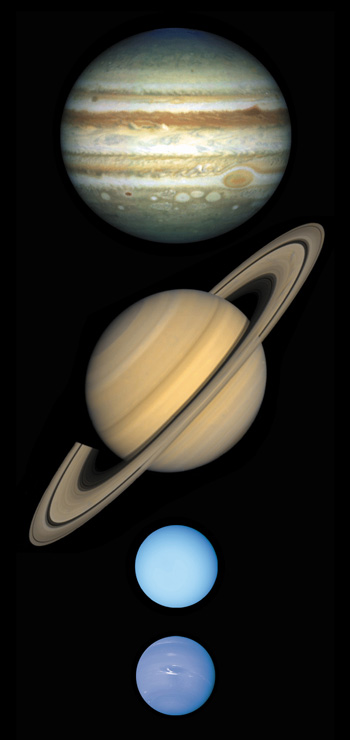
Uranus, which rotates on its side, and Neptune are of similar size and color, although Neptune seems to have a more active atmosphere despite its much greater distance from the Sun. Both planets are composed primarily of rock and various ices. Their extensive atmospheres, which make up about 15 percent the mass of each planet, are composed of hydrogen with a little helium. Both Uranus and Neptune have a retinue of diverse and interesting moons. These two cold and distant planets have had but one visitor, the intrepid Voyager 2.
The gas giants have numerous satellites, many of which are large, and seem as interesting as any planet. Small "new" satellites of the Jovian planets are being discovered every few years.
Jupiter's Galilean satellites, so named because Galileo Galilei discovered them in 1610, exhibit great diversity from each other. All four can be easily seen in a small telescope or binoculars. Io, is the closest of these to Jupiter. Io is the most volcanically active body in the solar system, due to heat resulting from tidal forces (discussed further in Chapter 3) which flex its crust. Powerful Earth-based telescopes can observe volcanoes resurfacing Io continuously. Europa is covered with an extremely smooth shell of water ice. There is probably an ocean of liquid water below the shell, warmed by the same forces that heat Io's volcanoes. Ganymede has mountains, valleys, craters, and cooled lava flows. Its ancient surface resembles Earth's moon, and it is also suspected of having a sub-surface ocean. Callisto, the outermost Galilean moon, is pocked all over with impact craters, indicating that its surface has changed little since the early days of its formation.
Saturn's largest moon, enigmatic Titan, is larger than the planet Mercury. Almost a terrestrial planet itself, Titan has a hazy nitrogen atmosphere denser than Earth's. The Huygens probe's spectacularly successful mission in 2005 revealed rivers and lakebeds on the surface, and extensive details of its complex atmosphere.
Saturn also has many smaller and unexpectedly diverse satellites made largely of water ice. The "front," or leading, side of Saturn's icy satellite Iapetus is covered in dark material of some kind, and an equatorial mountain range as high as 13 kilometers was recently discovered on this 1450-km diameter moon. Icy Enceladus orbits within the densest part of Saturn's E Ring, and has recently been shown to be the source of that ring's fine ice-particle makeup. Cassini spotted a system of crevasses near the south pole of Enceladus, and determined that the temperature in the crevasses is warmer than that of the rest of the 500-km diameter body. In November 2005, backlit images showed fountains of water-ice particles spewing from Enceladus's south polar region. This activity is very surprising to observe on such a small icy satellite. Ammonia was discovered within Enceladus' icy plumes in 2009, supporting the possibility of sub-surface liquid water and making Enceladus one of the most likely places to harbor life. The exact cause of the icy founts themselves has yet to be determined.
All of Uranus's five largest moons have extremely different characteristics. The surface of Miranda, the smallest of these, shows evidence of extensive geologic activity. Umbriel's surface is dark, Titania and Ariel have trenches and faults, and Oberon's impact craters show bright rays similar to those on Jupiter's Callisto and our own moon.
Neptune's largest moon Triton is partly covered with nitrogen ice and snow, and has currently active nitrogen geysers that leave sooty deposits on the surface downwind.
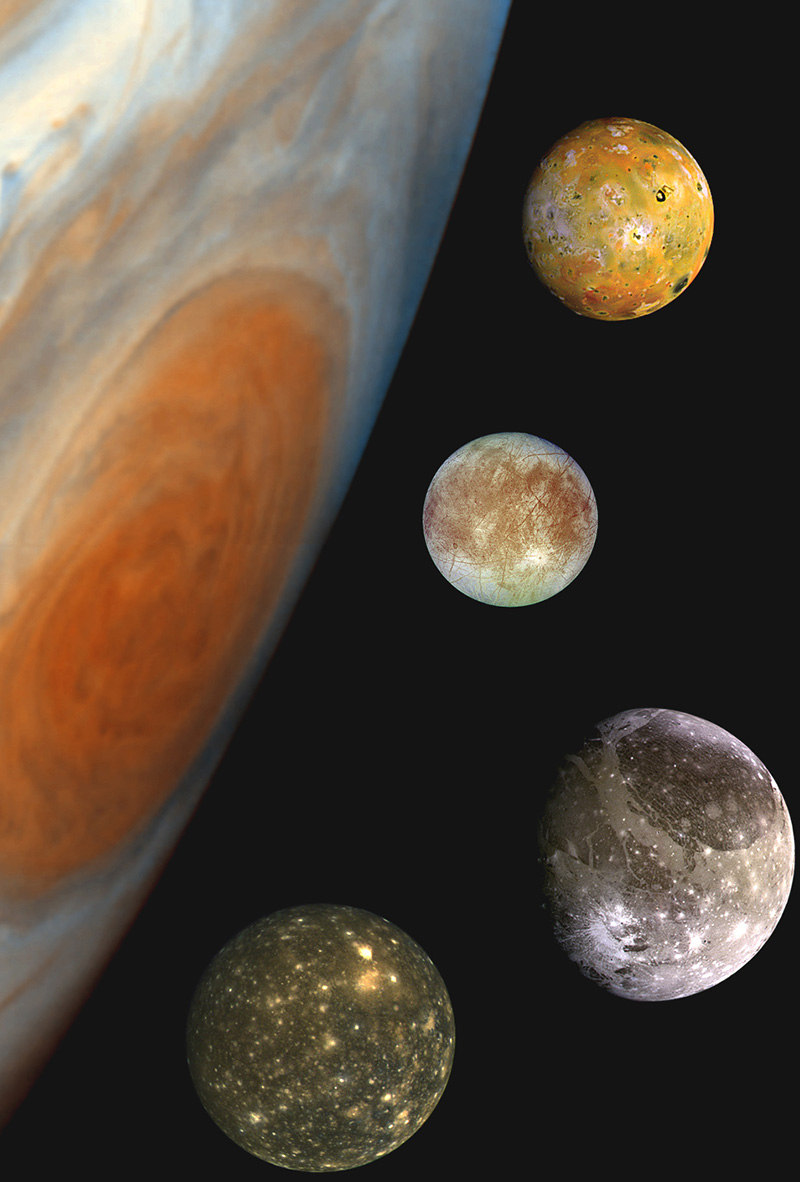
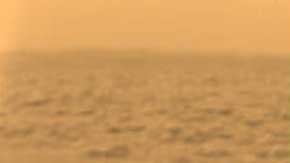
Jupiter's equatorial dust rings can be detected at close range in visible light and from Earth in the infrared. They show up best when viewed from behind, in forward scattered Sunlight. Saturn, Uranus and Neptune all have rings made up of myriad particles of ice ranging in size from dust and sand to boulders. Each particle in a ring is an individual satellite of the planet in its own right. Ring particles interact with each other in complex ways, affected by gravity and electrical charge. They also interact with the thin extended atmospheres of the planets. Saturn's magnificent ring system, as visible from Earth, spans about 280,000 km, yet its thickness at any given point is less than 100 meters! The A-ring, measured at several points, was found to be only 10 meters thick.
There are some cases where two natural satellites occupy orbits very close to each other within a ring system, one satellite orbiting slightly farther from the planet than the ring, and the other satellite orbiting closer to the planet than the ring. The effect is that the satellites confine ring particles between their orbits into a narrow ring, by gravitationally interacting with the ring particles. These satellites are called shepherd moons. Examples are seen at Saturn and at Uranus.

Mean distance from Sun (au) | 5.20 au | 9.58 au | 19.20 au | 30.05 au |
|---|---|---|---|---|
Light hours from Sun | 0.72 | 1.3 | 2.7 | 4.2 |
Mass (x Earth) | 317.8 | 95.2 | 14.5 | 17.1 |
Radius (x Earth) | 11.21 | 9.45 | 4.01 | 3.88 |
Rotation period (hours) | 9.9 | 10.7 | 17.2 | 16.1 |
Orbit period (Earth years) | 11.9 | 29.4 | 83.7 | 163.7 |
Mean orbital velocity (km/s) | 13.07 | 9.69 | 6.81 | 5.43 |
Known natural satellites (as of January 2013) | ||||
Rings | Dust | Extensive system | Thin, dark | Broken ring arcs |
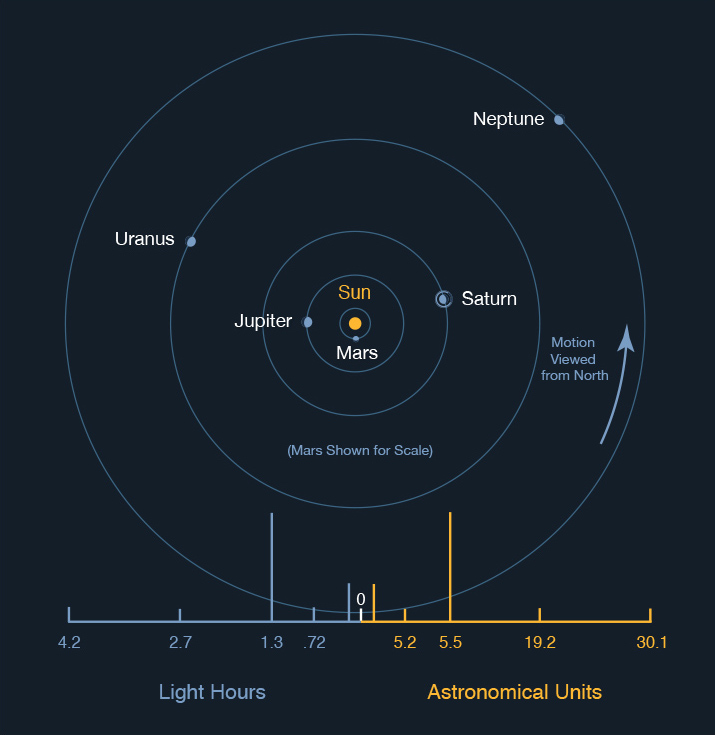
Mercury and Venus are referred to as inferior planets, not because they are any less important, but because their orbits are closer to the Sun than is Earth's orbit. They always appear close to the Sun in Earth's morning or evening sky; their apparent angle from the Sun is called elongation. The outer planets, Mars, Jupiter, Saturn, Uranus, and Neptune, are all known as superior planets because their orbits are farther from the Sun than the Earth's.
Inferior planets may pass between the Earth and the Sun on part of their orbits, so they can exhibit nearly the complete range of phases from the Earth's point of view... from the dark "new" phase, to slim "crescent" phase, to the mostly lit "gibbous" phase (approximating the fully illuminated "full" phase when approaching the other side of the Sun). Our own moon, of course, exhibits all the phases. Superior planets, though, usually appear gibbous, and appear full only when at opposition (see below), from our Earthly point of view.
Viewed from superior planets, Earth goes through phases. Superior planets can be seen as crescents only from the vantage point of a spacecraft that is beyond them.
When two bodies appear to pass closest together in the sky, they are said to be in conjunction. When a planet passes closest to the Sun as seen from Earth and all three bodies are approximately in a straight line, the planet is said to be in solar conjunction. The inferior planets Venus and Mercury can have two kinds of conjunctions with the Sun: (1) An inferior conjunction, when the planet passes approximately between Earth and Sun (if it passes exactly between them, moving across the Sun's face as seen from Earth, it is said to be in transit); and (2) A superior conjunction when Earth and the other planet are on opposite sides of the Sun and all three bodies are again nearly in a straight line. If a planet disappears behind the Sun because the Sun is exactly between the planets, it is said to be in occultation.
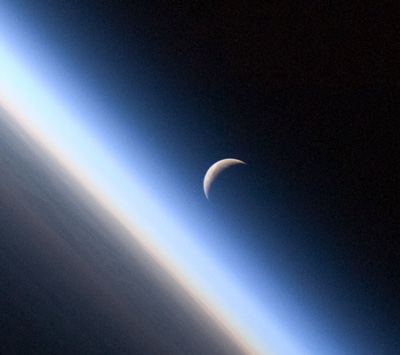
Superior planets can have only superior conjunctions with the Sun, as viewed from Earth. At superior conjunction the outer planet appears near its completely illuminated full phase.
The planet is said to be at opposition to the Sun when both it and the Earth are on the same side of the Sun, all three in line. (The moon, when full, is in opposition to the Sun; the Earth is then approximately between them.)
Opposition is a good time to observe an outer planet with Earth-based instruments, because it is at its nearest point to the Earth and it is in its fullest phase.
Inferior planets can never be at opposition to the Sun, from Earth's point of view.
Occultations, transits, conjunctions, and oppositions offer special opportunities for scientific observations by spacecraft. Studies of the solar corona and tests of general relativity can be done at superior conjunctions. Superior conjunctions also present challenges communicating with a spacecraft nearly behind the Sun, which is overwhelmingly noisy at the same radio frequencies as those used for communications. At opposition, such radio noise is at a minimum, presenting ideal conditions for gravitational wave searches. These special opportunities and challenges are further discussed in later chapters.
